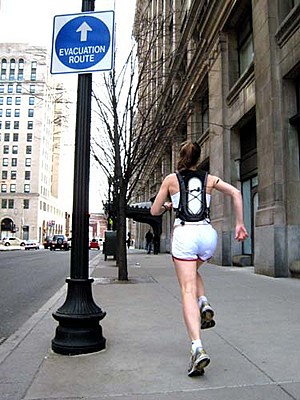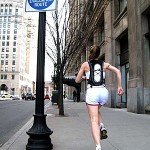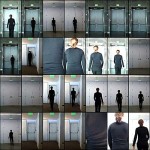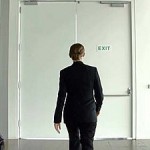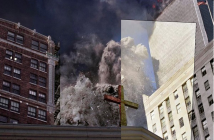2008 ICA FOSTER PRIZE FINALISTS: A CONVERSATION WITH CATHERINE D'IGNAZIO
On November 12th, the 2008 James and Audrey Foster Prize exhibition opened at the Institute of Contemporary Art, Boston.Catherine D'Ignazio, co-creator of The Institute for Infinitely Small Things (and sometimes known as Kanarinka) is one of the four artists competing for the $25,000 biennial prize, and Big RED publisher Matthew Nash caught up with her at her studio loft in Waltham for a conversation about her pieces It Takes 154,000 Breaths To Evacuate Boston and Exit Strategy.
----
Matthew Nash: Can you talk about some of your previous projects that deal with "fear culture" and post-9/11 fear, and how they led to the piece at the ICA?
Catherine D'Ignazio: The previous projects were all with my group, The Institute for Infinitely Small Things. I'm trying to think of what the first one actually was, I guess the first one was the New American Dictionary project. That was a dictionary of terms for post-9/11 America, and they were terms that we claimed had either entered the English language since 9/11 or had been transformed. So, words like "freedom fries". "Duct tape" has taken on a whole new meaning. Words like "us" and "them" have taken on whole new meanings as well. Of course, there are also words like "torture", which have been legally redefined by the Bush administration.
That's where the interest started in the language landscape of post-9/11 culture. From there, we started working on the projectUnmarked Package, which was actually a video project and performance where we took boxes labeled "unmarked package" around Chicago and used them as a kind of sculpture and a way to interview people about how they felt in public space.
MN: When I think about work that The Institute has done, it seems to me that it is always work designed to provoke dialogue with the public. Even the work that isn't necessarily about fear culture, like The City Formerly Known As Cambridge or Corporate Commands, it's always about provoking conversation. So, what struck me as different about the piece at the ICA is how much more internalized it feels. How did you get there, and what led you to break from The Institute's traditions?
CD: It's similar in the sense that it has a lot of shared concerns. It is concerned with ideas of public space and a kind of culture of public space. So, the question that the piece at the ICA really asks is "How do we feel differently now, in public spaces?" It is really about being more scared and anxious, having more fear, both internally but also with these external markers of that fear. These are signs, like the Evacuation Route signs, and so on.
In this project, I think the short answer is that I was tired of talking to people... (laughter)... I was interested in doing something that was more about internal states. I think after having done Unmarked Package and having spoken with people in public spaces about their feelings, I think that piece turned out to be very useful for us in the way that people's thoughts differed based on the geography of Chicago and the demographics of who was answering our questions. At the same time, I was thinking about how not talking to people is also a viable way of doing research. I wouldn't say it's more internally focused, necessarily, but it is trying to get at a more internal state of mind, a psychological state of mind, through the doing of an action just by me.
MN: I know that, independent of your artistic life, you are also very athletic. You've competed in one triathlon that I know of...
CD: I've competed in the triathlon a bunch of times and I have run four or five marathons.
MN: I know how athletes often go into their own mental space while running, and I suspect that through the running of the Evacuation routes you had to internalize a lot of these ideas about how fear is created. Do you feel you conveyed that experience in the installation at the ICA?
CD: The piece at the ICA was a challenge because it's not a way that I tend to work. I don't typically work in a gallery space like that, although based on this project and another one I'm in the process of creating, this might be a more regular component for me. So there was a certain level of translation that had to happen. How do I make it fresh and new and interesting for this audience, and not just documentation of me running? Here are some photos of me, doing this action... that's not very interesting, and it doesn't carry any of the psychological weight that I hope the piece does have. It doesn't produce that kind of experience for a visitor to the gallery space.
So, I did some intricate gymnastics with the placement of the Evacuation routes, trying to place them into the ICA architecture, and really trying to think about the visitor to the space as myself, re-enacting that evacuation process. So they are walking on top of the map of the Evacuation Routes. They are hearing, through directional speakers, the repetitive breathing, over and over. There's the slamming of doors that's in the video piece Exit Strategy.
What I'm trying to get at through those things is, getting back to what you were asking, I think it's about that repetitive nature of fear. The act of trying to leave, trying to leave, over and over again. This is what I did with my own body as I was running the Evacuation Routes. But then, of course, you don't ever really get anywhere. So that's the state that I'm hoping to put people at ICA in as well, potentially feeling somewhat claustrophobic and this feeling that this just keeps going and going, and we're trapped in our own fantasies of disaster and fantasies of safety. But it's really a very internal experience, and that's a key difference with some of The Institute's work, it's this more internal state of affairs I'm trying to get at.
MN: You brought up the Exit Strategy video, which to me felt like the most specific to the ICA space and a pretty successful way of paring down the large story to a smaller and more recognizable context. What was the conception process for that piece and how do you see it fitting in with the evacuation project?
CD: When I was thinking about having the evacuating piece as part of the show, I started by thinking that I'd install my breathing sounds along the ICA's actual evacuation routes. The building, as all public buildings do, has it's own evacuation routes. That was my starting point, and I was thinking about how to keep correlating these ideas about evacuating Boston and also evacuating the ICA, to somehow make that experience more urgent or more present for the people who would be there in the ICA. The one way was the planting of sounds along the evacuation routes, but then I was thinking that, say, we were really evacuating the ICA. What would that look like? I wanted to create a piece that riffs on the Evacuation piece but in a more present way for the people who are experiencing the space now. That's how I came up with the idea for Exit Strategy, which is just repeatedly exiting every single door in the ICA. It's cut in a way that I'm always just going toward the door, and I never actually pass through.
MN: That's the piece that creates a real sense of urgency in the space. It propels you forward and makes you anxious and uncomfortable. My experience was of reading the wall text description of the project and anticipating the subtle breathing sounds I would hear, but all the while the slamming of the doors in the video ratchets up the heartbeat.
CD: The other impetus was that I felt like I needed a more visceral, visual component to the space. I needed something urgent, that was about urgency and felt like it was about now. My performance actions had all happened in the past and it needed somehow to be brought into that space.
MN: How do you feel about the competitive aspect of the Foster Prize exhibition? Is it something that you think about?
CD: There are certain things I think are kind of silly about having a competition. I think the idea that one of us is better than the others is kind of silly, because we are doing such different work. Our concerns and our projects are just so different. That said, I understand the impetus behind it because the idea of the competition does benefit the larger Boston art scene. I know that's the goal of the Fosters and the ICA, to make Boston a more interesting place for contemporary work. So this competitive aspect might help that, and get more people out and excited about the artists in Boston.
- Catherine D’Ignazio, It Takes 154,000 Breaths To Evacuate Boston, 2008.
- Catherine D’Ignazio, Exit Strategy, (video stills), 2008.
- Catherine D’Ignazio, Exit Strategy, (detail), 2008.
2008 ICA FOSTER PRIZE FINALISTS: A CONVERSATION WITH ANDREW WITKIN by MICAH J. MALONE in issue #95
The Institute of Contemporary Art
"The James and Audrey Foster Prize Finalists" is on view November 12th, 2008 - March 1st, 2009 at the ICA.
All images are courtesy of the artist and The ICA.

